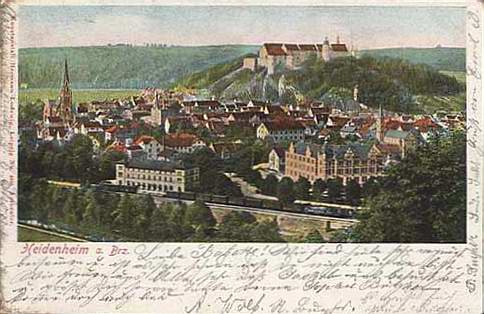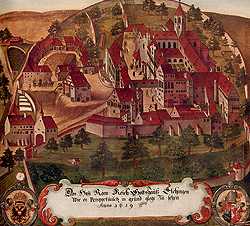|
Aalen–Ulm Railway
The Aalen–Ulm railway, also called the Brenzbahn (Brenz Railway}) or the Brenztalbahn (Brenz Valley Railway), is a single-tracked, non-electrified main line from Aalen to Ulm in southern Germany. It is long and, for , follows the Brenz River that gives it its name. History In the 1830s a commission was established on behalf of King William I of Württemberg to investigate whether a railway would be a suitable means to connect the Neckar with Lake Constance and to expedite the movement of goods in Württemberg. For the Eastern Railway (''Ostbahn'') from Stuttgart to Ulm, the experts examined both a route along the Rems and Brenz, as well as along the Fils. Although the escarpment of the Swabian Alb posed a difficult obstacle to overcome for the Fils route, it was selected in preference to a route along the Brenz because it did not need to pass through Bavaria. The so-called Brenz railway clause was historically important for the railways. This was part of a treaty contract ... [...More Info...] [...Related Items...] OR: [Wikipedia] [Google] [Baidu] |
Aalen Station
Aalen Hauptbahnhof is a junction on the Rems Railway from Stuttgart, the Brenz Railway from Ulm, the Upper Jagst Railway to Crailsheim and Ries Railway to Donauwörth. The station is located 200 metres northeast of the historic old town ( Altstadt) of Aalen in the German state of Baden-Württemberg. It is classified by Deutsche Bahn as a category 3 station. Aalen station was renamed a ''Hauptbahnhof'' (main station) at the timetable change on 11 December 2016. History Despite disagreements between the countries of Württemberg and Bavaria, which did not have a common concept of a cross-border railway, the Rems Railway (german: link=no, Remsbahn) was opened by the Royal Württemberg State Railways on 18 July 1861. Aalen was not planned as a railway junction and the station at first was small with eight railway employees who also had postal duties. An extension of the railway towards Nördlingen—now considered part of the Ries Railway (''Riesbahn'')—opened on 3 October 186 ... [...More Info...] [...Related Items...] OR: [Wikipedia] [Google] [Baidu] |
Sontheim An Der Brenz
Sontheim (full name: Sontheim an der Brenz) is a municipality in the district of Heidenheim in Baden-Württemberg in southern Germany. It is located northeast of Ulm, at the southern end of the Swabian Jura. Neighboring municipalities Sontheim shares borders with the following towns and villages: Hermaringen (Heidenheim District) in the north, Bächingen an der Brenz (Dillingen District, Bavaria) in the east and the south, as well as Niederstotzingen (Heidenheim District) in the west. Villages Sontheim an der Brenz consists of the main community Sontheim and the villages of Brenz and Bergenweiler. Brenz and Bergenweiler became part of Sontheim during Baden-Württemberg's last district reform in the 1970s. Twin towns The town is twinned with: * Saint-Valery-en-Caux, France France (), officially the French Republic ( ), is a country primarily located in Western Europe. It also comprises of Overseas France, overseas regions and territories in the Americas and the ... [...More Info...] [...Related Items...] OR: [Wikipedia] [Google] [Baidu] |
Single Track (rail)
A single-track railway is a railway where trains traveling in both directions share the same track. Single track is usually found on lesser-used rail lines, often branch lines, where the level of traffic is not high enough to justify the cost of constructing and maintaining a second track. Advantages and disadvantages Single track is significantly cheaper to build and maintain, but has operational and safety disadvantages. For example, a single-track line that takes 15 minutes to travel through would have capacity for only two trains per hour in each direction safely. By contrast, a double track with signal boxes four minutes apart can allow up to 15 trains per hour in each direction safely, provided all the trains travel at the same speed. This hindrance on the capacity of a single track may be partly overcome by making the track one-way on alternate days, if the single track is not used for public passenger transit. Long freight trains are a problem if the passing s ... [...More Info...] [...Related Items...] OR: [Wikipedia] [Google] [Baidu] |
Neu-Ulm–Kempten Railway
The Neu-Ulm–Kempten railway is a mostly single track and non-electrified main line from Neu-Ulm via Memmingen to Kempten in the German state of Bavaria. It follows the Iller river for its entire length and is therefore also called the Iller Valley Railway (german: Illertalbahn). The line from Neu-Ulm to Kellmünz is integrated in the Donau-Iller-Nahverkehrsverbund (Danube-Iller Local Transport Association, DING). It is listed in the timetable under the number of 975; between New Ulm and Memmingen it is also served by services running on route 756. History Kempten citizens proposed a railway line to Ulm via Memmingen in 1843, as the construction of dams and water mills during the period of industrialisation had ended raft traffic on the river Iller and road transport was not viable. The Bavarian government, however, was not interested in further construction in this area. Because Memmingen was not then included in plans for the first railways in the country, the city took the i ... [...More Info...] [...Related Items...] OR: [Wikipedia] [Google] [Baidu] |
Ulm–Augsburg Railway
The Ulm–Augsburg line is a German railway line. It was constructed as part of the Bavarian Maximilian's Railway. It was built for the Royal Bavarian State Railways as part of the east-west connection between Neu-Ulm in the west via Augsburg, Munich and Rosenheim to the Austrian border at Kufstein and Salzburg in the east. History The line was constructed as part of the ''Bavarian Maximilian Railway'' (German:''Bayerische Maximiliansbahn''), named after Maximilian II, king of Bavaria from 1848 to 1864. In 1851, it was decided to build a line connecting the German states and Italy via the Brenner Pass and via Salzburg towards Vienna and the Semmering Pass. It promised good traffic flows to and from the Austrian Adriatic port at Trieste. Appropriate conventions were agreed with the Kingdom of Württemberg and with the Austrian government in 1851. The Munich–Augsburg line, which had been opened by the Munich–Augsburg Railway Company (''München-Augsburger Eisenbahn-Gesel ... [...More Info...] [...Related Items...] OR: [Wikipedia] [Google] [Baidu] |
Ingolstadt–Neuoffingen Railway
The Ingolstadt–Neuoffingen railway is a single-track, electrified mainline railway in Bavaria, Germany. It runs in the Danube valley from Ingolstadt via Neuburg an der Donau, Donauwörth and Dillingen an der Donau to Neuoffingen, where it joins the Augsburg–Ulm railway. The Ingolstadt–Neuoffingen railway and the Regensburg–Ingolstadt railway together form the Bavarian Danube Valley Railway (''Donautalbahn''). History Thirteen towns along the Danube between Günzburg and Regensburg considered that they had been neglected by the Bavarian state parliament when it came to railways. They therefore founded a railway committee in 1863 and presented it with a memorandum. A deputation travelled to Munich on 20 October 1866 to underline the need for a line to be built by the Royal Bavarian State Railways. As a result the proposal began to progress. A draft proposal was submitted to the Bavarian Landtag (Parliament) on 28 January 1868. The Landtag approved 1.595 millio ... [...More Info...] [...Related Items...] OR: [Wikipedia] [Google] [Baidu] |
Ulm–Friedrichshafen Railway
The Ulm–Friedrichshafen railway, also known as the Württembergische Südbahn (Württemberg Southern Railway), is an electrified main line in the state of Baden-Württemberg, southern Germany. It was built from 1846 to 1850 and doubled from 1905 to 1913. During that time many of the station buildings were rebuilt. Its kilometre numbering (chainage) begins as the Fils Valley Railway in Stuttgart Hbf. The line was upgraded and electrified from the spring of 2018. Electric operations commenced in December 2021. The line begins in Ulm and runs via Biberach an der Riß, Aulendorf and Ravensburg to Friedrichshafen. Some trains continue on the single-tracked line of the Friedrichshafen–Lindau railway to Lindau. History Under the technical direction of the civil engineer Ludwig Friedrich Gaab, commissioners Ludwig August von Autenrieth and Georg von Buhler examined a transport link between Ulm and Friedrichshafen from 1836. As an alternative, a canal link was considered using the Ri ... [...More Info...] [...Related Items...] OR: [Wikipedia] [Google] [Baidu] |
Ulm–Sigmaringen Railway
The Ulm–Sigmaringen railway is a 92.670-kilometre-long railway in Baden-Württemberg in south-western Germany, which is largely single-tracked and for the most part not electrified. It runs from Ulm via Blaubeuren and Riedlingen to Sigmaringen mostly in the valley of the Danube. The line is part of the once important long-distance connection from Munich to Freiburg im Breisgau. It forms part of the Danube Valley Railway of Baden-Württemberg. The line is famous especially for its charming course through the Upper Danube Nature Park (''Naturpark Obere Donau''), and is particularly attractive to bicycle tourists. The Royal Württemberg State Railways built the line as part of the railway projects undertaken between 1865 and 1873. Since 1901, the Danube Valley Railway, together with the Höllentalbahn, form part of the pan-regional railway link from Ulm to Freiburg im Breisgau. Danube Valley Railway (Baden-Württemberg) The line forms part of the Danube Valley Railway (German: ' ... [...More Info...] [...Related Items...] OR: [Wikipedia] [Google] [Baidu] |
Fils Valley Railway
The Fils Valley Railway (german: Filstalbahn, historically ''Filsbahn'' or ''Württembergische Ostbahn''—Württemberg Eastern Railway) designates the Württemberg line from Stuttgart via Göppingen to Ulm. It runs from Plochingen to Geislingen an der Steige through the Fils Valley. History Construction The Fils Valley Railway was built as part of the first railway line in Württemberg connecting the navigable Neckar in Heilbronn via Stuttgart with the navigable Danube at Ulm, with a further connection from Ulm to Lake Constance. The Stuttgart-Esslingen section of the line was built as part of the Central Railway (''Zentralbahn'') between 1844 and 1846. The line was completed between Cannstatt and Esslingen on 22 October 1845 and the Rosenstein Tunnel was completed on 4 July 1846, allowing the first train to run into Stuttgart station on 26 September 1846. It was extended to Plochingen in December 1846 and on 28 June 1850, the first train rolled over the new s ... [...More Info...] [...Related Items...] OR: [Wikipedia] [Google] [Baidu] |
Ulm Ost Station
Ulm Ost station is a railway station in the eastern part of the town of Ulm, located in Baden-Württemberg, Germany Germany,, officially the Federal Republic of Germany, is a country in Central Europe. It is the second most populous country in Europe after Russia, and the most populous member state of the European Union. Germany is situated betwe .... References {{Authority control Ost ... [...More Info...] [...Related Items...] OR: [Wikipedia] [Google] [Baidu] |
Elchingen
Elchingen is a municipality about 7 km east of Ulm–Neu-Ulm in the district of Neu-Ulm in Bavaria, Germany. Municipality parts: * Thalfingen: 4 211 residents, 8.83 km² * Oberelchingen: 3 024 residents, 7.31 km² * Unterelchingen: 2 863 residents, 8.76 km² History In 1294, Elchingen (today: Unterelchingen) was sold by Konrad of Plochingen to the Cistercian monastery of Salem. Unterelchingen stayed in its property until the secularization in 1802. Unterelchingen never was in possession of the Monastery of Elchingen. In 1803, Ober-, Unter-elchingen and Thalfingen became Bavarian, due to the Principal Decree of the Imperial Deputation. The Benedictine monastery of Elchingen was founded at the beginning of the 12th century. In 1395 all authentic documents were destroyed in a fire. So the probable consecration date (15 August 1128) cannot be proven. Around 1500, the German Conquistador Ambrosius Ehinger was born there. He later went on to be ... [...More Info...] [...Related Items...] OR: [Wikipedia] [Google] [Baidu] |
Langenau (Württ) Station
Langenau (Württ) station is a railway station in the municipality of Langenau, located in the Alb-Donau-Kreis in Baden-Württemberg, Germany Germany,, officially the Federal Republic of Germany, is a country in Central Europe. It is the second most populous country in Europe after Russia, and the most populous member state of the European Union. Germany is situated betwe .... References {{Authority control Railway stations in Baden-Württemberg Buildings and structures in Alb-Donau-Kreis ... [...More Info...] [...Related Items...] OR: [Wikipedia] [Google] [Baidu] |








